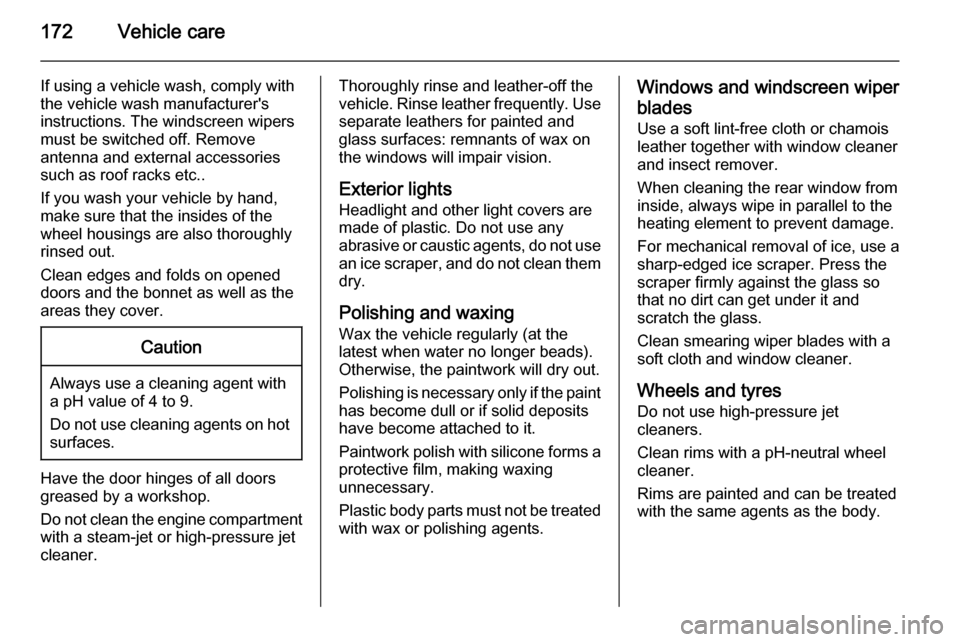Page 172 of 209

170Vehicle care
engine mounting bolt. Connect asfar away from the discharged
vehicle battery as possible,
however at least 60 cm.
Route the leads so that they cannot
catch on rotating parts in the engine
compartment.
To start the engine: 1. Start the engine of the vehicle providing the jump start.
2. After 5 minutes, start the other engine. Start attempts should be
made for no longer than
15 seconds at an interval of
1 minute.
3. Allow both engines to idle for approx. 3 minutes with the leads
connected.
4. Switch on electrical consumers (e.g. headlights, heated rear
window) of the vehicle receiving
the jump start.
5. Reverse above sequence exactly when removing leads.Towing
Towing the vehicle The towing eye is stowed with the
vehicle tools 3 155.
Disengage the cover using a suitable
tool and remove.
Screw the towing eye clockwise into
the front towing point and tighten fully using the wheel wrench.
Attach a tow rope - or better still a tow
rod - to the towing eye, never to the
bumper or front suspension units.
Caution
Do not tow the vehicle from the
rear. The front towing eye must
only be used for towing and not
recovering a vehicle.
Switch on ignition to release steering
wheel lock and to permit operation of
brake lights, horn and windscreen
wipers.
Switch off the air suspension system
3 114.
Transmission in neutral.
If neutral cannot be selected on
vehicles with MTA transmission, the vehicle must only be towed with the
drive wheels raised off the ground.
Caution
Drive slowly. Do not drive jerkily.
Excessive tractive force can
damage the vehicle.
When the engine is not running,
considerably more force is needed to
brake and steer.
Page 174 of 209

172Vehicle care
If using a vehicle wash, comply with
the vehicle wash manufacturer's
instructions. The windscreen wipers must be switched off. Remove
antenna and external accessories
such as roof racks etc..
If you wash your vehicle by hand,
make sure that the insides of the
wheel housings are also thoroughly
rinsed out.
Clean edges and folds on opened
doors and the bonnet as well as the
areas they cover.Caution
Always use a cleaning agent with
a pH value of 4 to 9.
Do not use cleaning agents on hot surfaces.
Have the door hinges of all doors
greased by a workshop.
Do not clean the engine compartment with a steam-jet or high-pressure jet
cleaner.
Thoroughly rinse and leather-off the vehicle. Rinse leather frequently. Use
separate leathers for painted and
glass surfaces: remnants of wax on
the windows will impair vision.
Exterior lights
Headlight and other light covers are
made of plastic. Do not use any
abrasive or caustic agents, do not use an ice scraper, and do not clean them
dry.
Polishing and waxing Wax the vehicle regularly (at the
latest when water no longer beads).
Otherwise, the paintwork will dry out.
Polishing is necessary only if the paint
has become dull or if solid deposits
have become attached to it.
Paintwork polish with silicone forms a
protective film, making waxing
unnecessary.
Plastic body parts must not be treated with wax or polishing agents.Windows and windscreen wiper
blades
Use a soft lint-free cloth or chamois leather together with window cleanerand insect remover.
When cleaning the rear window from
inside, always wipe in parallel to the
heating element to prevent damage.
For mechanical removal of ice, use a
sharp-edged ice scraper. Press the
scraper firmly against the glass so
that no dirt can get under it and
scratch the glass.
Clean smearing wiper blades with a
soft cloth and window cleaner.
Wheels and tyres Do not use high-pressure jet
cleaners.
Clean rims with a pH-neutral wheel
cleaner.
Rims are painted and can be treated
with the same agents as the body.
Page 186 of 209
184Technical dataVehicle weight
Kerb weight, basic model without any optional equipment Optional equipment and accessories increase the kerb weight.ModelDrive wheelsLengthRoof heightGross vehicle weightKerb weight 3)4)VanFront-wheel driveL1H1280018063300181135001816H2280018343300183935001844L2H23300188535001890H33300192135001931L3H235001970H3350020103)
Kerb weight and gross vehicle weight increase on models fitted with bad road equipment package - refer to identification plate.
4) Minimum vehicle weight according to type approval, including all fluids, vehicle tools and a 90% fuel load. Excludes the weight of the driver and deletable
options, e.g. spare wheel, bulkhead and sliding side door. Final weight may vary according to the specification of the vehicle, e.g. options, deleted options
and accessories.
Page 187 of 209
Technical data185
ModelDrive wheelsLengthRoof heightGross vehicle weightKerb weight3)4)VanRear-wheel driveL3H235005)211035006)224645002246H33500 5)214835006)227945002279L4H23500 5)-7)3500 6)232445002324H335005)-7)3500 6)2366450023663)
Kerb weight and gross vehicle weight increase on models fitted with bad road equipment package - refer to identification plate.
4) Minimum vehicle weight according to type approval, including all fluids, vehicle tools and a 90% fuel load. Excludes the weight of the driver and deletable
options, e.g. spare wheel, bulkhead and sliding side door. Final weight may vary according to the specification of the vehicle, e.g. options, deleted options
and accessories.
5) With Single rear wheels.
6) With Twin rear wheels.
7) Figure not available at time of printing. Refer to identification plate on the right hand door pillar.
Page 188 of 209

186Technical data
ModelDrive wheelsLengthRoof heightGross vehicle weightKerb weight3)4)Platform CabFront-wheel driveL1H135001570L2H135001578H235001593L3H135001599H2350016133)
Kerb weight and gross vehicle weight increase on models fitted with bad road equipment package - refer to identification plate.
4) Minimum vehicle weight according to type approval, including all fluids, vehicle tools and a 90% fuel load. Excludes the weight of the driver and deletable
options, e.g. spare wheel, bulkhead and sliding side door. Final weight may vary according to the specification of the vehicle, e.g. options, deleted options
and accessories.ModelDrive wheelsLengthRoof heightGross vehicle weightKerb weight 3)4)Chassis CabFront-wheel driveL2H135001686L3H1350017073)
Kerb weight and gross vehicle weight increase on models fitted with bad road equipment package - refer to identification plate.
4) Minimum vehicle weight according to type approval, including all fluids, vehicle tools and a 90% fuel load. Excludes the weight of the driver and deletable
options, e.g. spare wheel, bulkhead and sliding side door. Final weight may vary according to the specification of the vehicle, e.g. options, deleted options
and accessories.
Page 189 of 209

Technical data187
ModelDrive wheelsLengthRoof heightGross vehicle weightKerb weight3)4)Chassis CabRear-wheel driveL2H135005)1835L3H135005)18603500 6)197545006)1975L4H13500 6)200545006)20053)
Kerb weight and gross vehicle weight increase on models fitted with bad road equipment package - refer to identification plate.
4) Minimum vehicle weight according to type approval, including all fluids, vehicle tools and a 90% fuel load. Excludes the weight of the driver and deletable
options, e.g. spare wheel, bulkhead and sliding side door. Final weight may vary according to the specification of the vehicle, e.g. options, deleted options
and accessories.
5) With Single rear wheels.
6) With Twin rear wheels.ModelDrive wheelsLengthRoof heightGross vehicle weightKerb weight 3)4)Crew CabFront-wheel driveL2H135001887L3H1350019153)
Kerb weight and gross vehicle weight increase on models fitted with bad road equipment package - refer to identification plate.
4) Minimum vehicle weight according to type approval, including all fluids, vehicle tools and a 90% fuel load. Excludes the weight of the driver and deletable
options, e.g. spare wheel, bulkhead and sliding side door. Final weight may vary according to the specification of the vehicle, e.g. options, deleted options
and accessories.
Page 190 of 209

188Technical data
ModelDrive wheelsLengthRoof heightGross vehicle weightKerb weight3)4)Crew CabRear-wheel driveL2H135005)2037L3H135005)20683500 6)215445006)2154L4H13500 6)222345006)22233)
Kerb weight and gross vehicle weight increase on models fitted with bad road equipment package - refer to identification plate.
4) Minimum vehicle weight according to type approval, including all fluids, vehicle tools and a 90% fuel load. Excludes the weight of the driver and deletable
options, e.g. spare wheel, bulkhead and sliding side door. Final weight may vary according to the specification of the vehicle, e.g. options, deleted options
and accessories.
5) With Single rear wheels.
6) With Twin rear wheels.ModelDrive wheelsLengthRoof heightGross vehicle weightKerb weight 3)4)BusFront-wheel driveL3H2390024933)
Kerb weight and gross vehicle weight increase on models fitted with bad road equipment package - refer to identification plate.
4) Minimum vehicle weight according to type approval, including all fluids, vehicle tools and a 90% fuel load. Excludes the weight of the driver and deletable
options, e.g. spare wheel, bulkhead and sliding side door. Final weight may vary according to the specification of the vehicle, e.g. options, deleted options
and accessories.
Loading information 3 67.
Page 191 of 209
Technical data189Vehicle dimensionsVan, DoublecabFront-wheel drive
Gross vehicle weight
2800,
3300,
3500
3300,
3500
3500
SizeL1L2L3Length [mm]504855486198Width without mirrors [mm]207020702070Width with mirrors [mm]247024702470Height - unladen (without antenna) [mm]
H12303--H22496/2500 8)2496/24998)2488H3-2745/27498)2744Wheelbase [mm]318236824332Track width [mm]
Front175017501750Rear1730173017308) 3500 GVW.